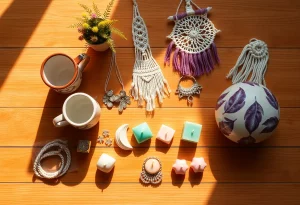Imagine turning your passion for crafting unique, handmade items into a thriving online business. With over 7.5 million active sellers and 96.3 million active buyers, Etsy has become a global marketplace where creative entrepreneurs can showcase their talents and connect with customers worldwide. This platform offers a golden opportunity for artisans to transform their hobbies into profitable ventures, all while celebrating the beauty of handcrafted goods.
Table of Contents
The Etsy Marketplace Landscape
Etsy has grown from a small startup to a global powerhouse for handmade, vintage, and unique goods. With over 96 million active buyers and 7.5 million active sellers as of 2022, Etsy has become a go-to platform for creative entrepreneurs.
The marketplace’s success stems from its focus on distinctive products. Top-performing categories include:
- Handcrafted jewelry
- Personalized gifts
- Home decor
- Vintage clothing
- Art prints
Etsy’s growth has outpaced many traditional e-commerce sites, with gross merchandise sales reaching $13.3 billion in 2021. This table highlights Etsy’s impressive trajectory:
| Year | Active Sellers | Active Buyers | Gross Merchandise Sales |
|---|---|---|---|
| 2019 | 2.7 million | 46 million | $5.0 billion |
| 2021 | 5.3 million | 90 million | $13.3 billion |
Unlike mass-market platforms, Etsy caters to shoppers seeking unique items. This niche focus has helped Etsy carve out a distinct space in the e-commerce world.
For sellers, Etsy offers a supportive community and tools to grow their businesses. The platform’s biggest sellers often share these traits:
- High-quality product photos
- Detailed item descriptions
- Excellent customer service
- Consistent branding
Check out this video for insights on turning your passion into an Etsy business:
While Etsy’s growth is impressive, managing multiple sales channels can be challenging. Tools like Marketplace Connect help sellers streamline operations across platforms, including Etsy, by syncing orders and inventory automatically.
For those inspired by Etsy’s success, creating a similar marketplace is possible. Learn more about building your own e-commerce empire in this helpful guide.
Crafting Your Etsy Success Strategy
Starting an Etsy shop can be exciting, but it takes some planning to stand out. Let’s break down the key steps to get your creative business off the ground.
First up, choosing the right products is crucial. Think about what you love making and what sells well. Unique, handmade items often catch buyers’ eyes on Etsy.
- Analyze trending categories
- Consider your skills and passions
- Research competitor offerings
Once you’ve picked your products, it’s time to create compelling listings. Great photos and descriptions can make or break your shop. Use natural light for your shots and write clear, engaging product details.
Pricing your handmade items can be tricky. You want to cover costs and make a profit, but stay competitive. A simple formula to start with:
| Cost | Calculation |
|---|---|
| Materials | Actual cost |
| Labor | Hours worked x hourly rate |
| Overhead | 20% of materials + labor |
| Profit margin | 25-50% of total costs |
Don’t forget to leverage Etsy’s tools to boost your visibility. Use relevant tags, optimize your shop title and description, and consider Etsy ads to get more eyes on your products.
This video offers some great tips for new Etsy sellers aiming to hit that $5,000 monthly goal. It’s packed with practical advice to help you get started on the right foot.
Learning from Etsy’s Biggest Sellers
Studying successful Etsy shops can teach us a lot. Let’s look at what some top sellers are doing right.
- Consistent branding across all listings
- Regular shop updates with new products
- Excellent customer service and quick response times
- Strategic use of Etsy’s promotional tools
One standout case is ThreeBirdNest, which grew from a small side hustle to a million-dollar business. They focused on trendy, affordable accessories and mastered the art of eye-catching product photography.
Common traits among top Etsy sellers include:
- High-quality, unique products
- Clear shop policies
- Prompt shipping
- Engaging with customers through social media
To adapt these winning strategies, start by picking one area to improve in your shop. Maybe it’s updating your product photos or refining your customer service approach. Small changes can lead to big results over time.
For a deeper dive into Etsy success stories, check out this case study on Etsy craft entrepreneurship. It offers valuable insights into how successful sellers navigate the platform.
Scaling Your Etsy Business with Multi-Channel Selling
As your Etsy shop grows, you might consider expanding to other platforms. Multi-channel selling can boost your reach and sales, but it comes with challenges.
Benefits of selling on multiple platforms include:
- Increased visibility for your brand
- Diversified income streams
- Access to different customer bases
However, managing inventory across platforms can be tricky. You need to keep track of stock levels and ensure you don’t oversell. This is where tools for streamlining operations come in handy.
| Challenge | Solution |
|---|---|
| Inventory management | Centralized inventory system |
| Order processing | Automated order syncing |
| Shipping | Integrated shipping tools |
One tool that can help simplify multi-channel management is Marketplace Connect. It integrates with Shopify and supports various marketplaces, including Etsy. This app syncs orders and inventory in real-time, saving you time and reducing errors.
If you’re curious about how to expand your craft business beyond Etsy, this article on harnessing the power of Etsy offers some great tips.
Remember, scaling your business takes time and effort. Start small, perhaps by adding one new sales channel, and gradually expand as you get comfortable managing multiple platforms.
Navigating Etsy’s Competitive Landscape
Etsy’s bustling marketplace can feel like a crowded art fair. With millions of sellers vying for attention, standing out requires more than just great products. Let’s break down some key strategies for long-term success on this creative platform.
Finding your niche is crucial. The biggest sellers on Etsy often carve out unique spaces for themselves. Consider these approaches:
- Combine two unexpected product categories
- Offer customization options others don’t
- Focus on an underserved customer segment
- Create products that solve specific problems
Building a strong brand identity helps you rise above the noise. This goes beyond just your shop name and logo. Your brand should tell a story that resonates with your ideal customers.
Balancing creativity with business smarts is an ongoing challenge. While your passion drives your products, remember these business essentials:
- Price your items to cover costs and make a profit
- Track your inventory and restock popular items
- Respond promptly to customer inquiries
- Continuously improve your product photos and descriptions
Etsy’s algorithm and policies can change, impacting your visibility and sales. Staying adaptable is key. Keep an eye on Etsy announcements and be ready to adjust your strategy. Some sellers even expand to other platforms to diversify their income streams.
Managing multiple sales channels can be complex. That’s where tools like Marketplace Connect come in handy. It helps sync your Etsy orders and inventory with other platforms, saving you time and reducing errors.
Remember, success on Etsy is a marathon, not a sprint. Keep refining your craft, listen to your customers, and stay true to your creative vision. With persistence and smart strategies, you can turn your passion into a thriving business on this vibrant marketplace.
For sellers looking to streamline their multi-channel operations, Marketplace Connect offers a solution to simplify order management across Etsy and other platforms.
Wrap-up
Etsy offers a unique platform for creative entrepreneurs to showcase their talents and build thriving businesses. By focusing on quality products, eye-catching photos, and stellar customer service, you can set yourself apart in this bustling marketplace. Remember, success on Etsy isn’t just about making sales – it’s about building a brand that resonates with your target audience.
As you embark on your Etsy journey, keep learning and adapting your strategies. The platform evolves, and so should your approach. Whether you’re just starting out or looking to boost your existing shop, there’s always room for growth. And don’t forget, tools like Marketplace Connect can streamline your operations if you’re selling across multiple channels.
Ready to take your creative business to the next level? The next section will answer some common questions about selling on Etsy and provide more tips to help you succeed. Let’s dive in and explore how you can make your mark in this vibrant community of makers and buyers.
Common Questions About Selling on Etsy
How much does it cost to start selling on Etsy?
Starting an Etsy shop is pretty affordable. It’s free to open your shop, but you’ll pay a small listing fee of $0.20 per item. When you make a sale, Etsy takes a 6.5% transaction fee. There’s also a payment processing fee of about 3% plus $0.25. Keep in mind, these costs can add up, so factor them into your pricing strategy.
What are the best-selling categories on Etsy?
Some of the biggest sellers on Etsy include handmade jewelry, home decor, and personalized gifts. Craft supplies and vintage items also do well. Digital products like printables and patterns are gaining popularity too. The key is finding a niche that matches your skills and passion.
How can I improve my Etsy shop’s visibility?
To boost your shop’s visibility, focus on these areas:
- Use clear, descriptive titles and tags
- Take high-quality photos of your products
- Write detailed item descriptions
- Encourage customer reviews
- Regularly add new listings
Consistency in these practices can help your shop appear in more search results.
Is it possible to make a full-time income on Etsy?
Yes, many sellers do make a full-time income on Etsy. It takes time, effort, and smart business strategies. Focus on creating unique products, providing excellent customer service, and managing your finances well. As your shop grows, tools like Marketplace Connect can help you manage orders and inventory across multiple platforms, making it easier to scale your business.
How long does it take to start seeing sales on Etsy?
The time it takes to see sales can vary widely. Some shops might get their first sale within days, while others might take weeks or months. It depends on factors like your products, pricing, shop presentation, and marketing efforts. Don’t get discouraged if it takes time – keep improving your listings and promoting your shop.
What are some common mistakes new Etsy sellers make?
New sellers often make these mistakes:
- Underpricing their items
- Not factoring in all costs when setting prices
- Neglecting shop policies and customer service
- Failing to optimize listings for Etsy search
- Not promoting their shop outside of Etsy
Avoiding these pitfalls can give your shop a better chance at success.





